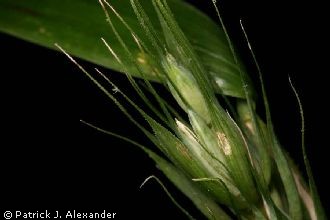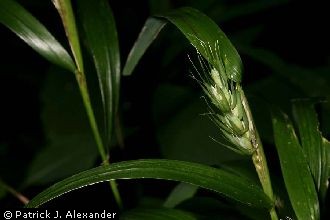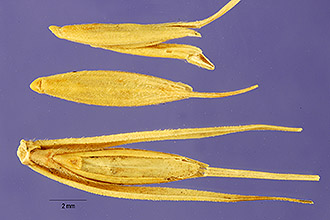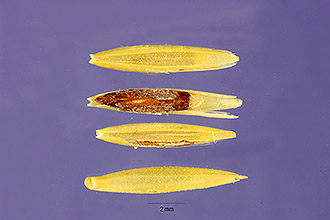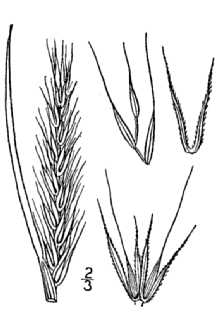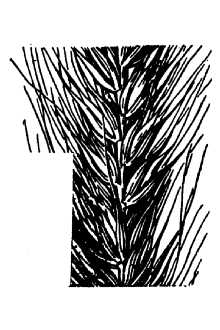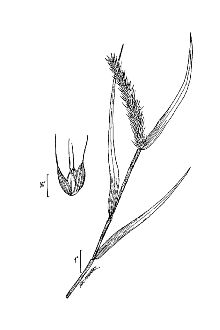Virginia Wildrye
Scientific Name: Elymus virginicus L.
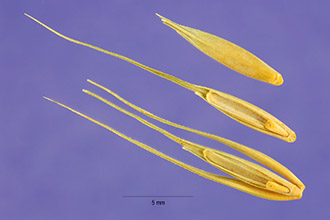
| General Information | |
|---|---|
| Usda Symbol | ELVI3 |
| Group | Monocot |
| Life Cycle | Perennial |
| Growth Habits | Graminoid |
| Native Locations | ELVI3 |
Plant Guide
Description
General: Virginia wildrye is a native, cool season, perennial, bunch grass. It is similar to Canada wildrye (Elymus canadensis) in appearance, but is typically shorter in height with shorter awns on the seed head. The seed heads are more erect than those of Canada wildrye which typically bow or droop (Philips Petroleum Company, 1963). There is evidence of variation in E. virginicus and E. canadensis due to hybridization of the two species (Grelen and Hughes, 1984). It reaches approximately three feet in height, lacks rhizomes and reproduces by seed and tillers. Seed heads are typically 3 to 6 inches in length, erect, and have numerous, coarse awns. Each spikelet has 2 or more florets that decrease in size as they extend to the end of the inflorescence. The glumes bow outward at the base producing a “U” shape and are strongly nerved (Hatch et al., 1993). The spiklets are densely packed on the inflorescence. They are sessile, have a pair of glumes with a cluster of 2 to 4 lemmas, and their florets (Hilty, 2009). Virginia wildrye blooms in the spring from March through May, and is wind pollinated (Hilty, 2009). Color may vary from green to silvery blue, and foliage often has a waxy appearance. The culms are tufted, strictly erect, or decumbent at the base. The ligule is a minute, truncated membrane (Gould, 1975). The alternately arranged leaves are approximately 12 inches in length and 2/3 inch in width. Virginia wildrye is typically hairless, but may have short pubescence on the leaf sheaths (Hilty, 2009). Distribution: Virginia wildrye has a very broad distribution, a testament to its adaptability. It may be found throughout the eastern 2/3rds of the United States, as far west as Arizona, and in the entire southern half of Canada. For current distribution, please consult the Plant Profile page for this species on the PLANTS Web site (http://plants.usda.gov). Habitat: Virginia wildrye is shade tolerant and is equally at home in open grasslands and prairies as it is in wooded sites. It is more shade tolerant than Canada wildrye, and prefers soils with more moisture and fertility (Philips Petroleum Company, 1963). It is commonly found in moist sites such as wet prairies, margins of wetlands, ditches, and riparian areas. It is also commonly found in woodlands, especially those in association with flood plains. It will adapt to disturbances and can be found in areas such as forest cut-overs (Hilty, 2009).
Adaptation
Virginia wildrye will tolerate a wide range of soil textures, from coarse sands to heavy clay. It prefers heavier soils with moderate fertility and a pH between 5 and 7. It has a moderate tolerance of drought and low tolerance of burning (Grelen and Hughes, 1984). It will not tolerate saline conditions. It can survive temperatures to negative 35o F. Virginia wildrye requires at least 15 inches of annual rainfall, and a minimum of 95 frost free days to reach maturity and produce seed (NRCS, 2009).
Uses
Livestock: Virginia wildrye is palatable and nutritious to all classes of livestock, It may be grazed fall through early spring before it produces its characteristic, awned, seed head, It may also be cut for hay; however, grazing and haying should be Natural Resources Conservation Service Plant Guide
Status
Threatened or Endangered: No Wetland Indicator: Virginia wildrye is a Facultative wetland (FACW) or Facultative (FAC) species Weedy or Invasive: Virginia wildrye is not known to be an invasive species. Please consult with your local NRCS Field Office, Cooperative Extension Service office, state natural resource, or state agriculture department regarding its status and use. Please consult the PLANTS Web site (http://plants.usda.gov/) and your state’s Department of Natural Resources for this plant’s current status (e.g., threatened or endangered species, state noxious status, and wetland indicator values).
Planting Guidelines
The seed requires no stratification or treatment, and typically produce greater than 85% germination (NRCS, 2009). For best results, prepare a clean, firm, weed free seedbed by disking, harrowing, and firming the seedbed with a cultipacker or roller prior to establishment. Rain or irrigation may also be used to settle and firm the field. If possible, allow an initial flush of weeds before planting, and treat with a non-selective, broad spectrum herbicide such as glyphosate in the 2-4 leaf stage. This will help reduce early weed pressure, and, may be done multiple times before planting if severe weed competition is anticipated. Seed should be planted in early spring (in the northern plains) or fall at a depth of approximately ¼ to ½ inch in heavy soils, and up to 1 inch deep in sandy soils (NRCS, 2009). Adequate soil moisture is critical for establishment of healthy stands. Seed should be drilled at 10-15 pure live seed (PLS) pounds per acre or broadcast at 20 PLS pounds per acre, when a monoculture is desired. Mixtures should be adjusted accordingly based on the desired concentration of plants. Virginia wildrye has approximately 96,000 seeds per pound (this varies considerably based on percent of seed with or without attached glumes).
Management
New plantings should not be fertilized during their first year of establishment. Fertilization at this time promotes weed competition. Established stands maybe fertilized according to current soil test recommendations. Warm season annual grasses can be very competitive in young plantings. However, their competitiveness is greatly reduced as temperatures cool, favoring the cool season Virginia wildrye. If annual grasses and other weeds become a problem during early establishment, they may be controlled using cultivation and mowing. Mowing above the Virginia wildrye will reduce the leaf area of taller weeds, making them less competitive, and can destroy weed seed before it reaches maturity. Cultivation is useful in seed production settings to control weeds between rows. Avoid deep cultivation as it decreases soil moisture and brings new weed seed to the surface to germinate. A wick applicator filled with a 50% glyphosate mixture is effective for tall weeds. Attach the wick applicator to an ATV or tractor and drive slowly through the planting with the wick positioned at a height to provide maximum control of target weeds, but above the Virginia wildrye plants. Broadleaf weeds may be controlled with selective herbicides such as 2, 4-D amine. Applications of post emergent herbicides should be done while weeds are young and not under stress such as drought. Pre-emergent herbicides are useful as broad spectrum weed control in established stands, but their use may only be applicable in monotypic stands and seed production situations. Please contact your local agricultural extension agent or extension weed specialist to learn what works best in your area and how to use it safely. Always read label and safety instructions for each control method. Trade names and control measures
Pests and Potential Problems
Several species of insects feed on Virginia wildrye including the leafhoppers (Dorycephalus platyrhynchus, Elymana acrita, Elymana acuma and Laevicephalus orientalis). Leaf hoppers suck juices from the foliage and create stress on the plant. The flea beetle (Chaetocnema pulicaria,), leaf beetle (Chalepus walshii) and the caterpillars of the False Wainscot moth (Leucania pseudoargyria) will feed on the foliage. Stink bugs are also known to feed on Virginia wildrye. These include brown stink bugs (Euschistus servus), green stink bug (Chinavia hilare, Coenus delia), and rough stink bug (Brochymena quadripustulata) (Hilty, 2009). White grub worms are also known to cause damage and should be controlled with a labeled pesticide when they are most active in late spring and early summer (NRCS, 2009). Seed heads can become heavily infested with ergot which causes toxicity problems in livestock (Phillips Petroleum Company, 1963). Virginia wildrye’s forage value decreases as it matures. When managed properly, it is baled at its nutritional peak, well before seed production; therefore, ergot should not be a problem. Elymus species are known to hybridize readily with one another (Gould, 1975). This may create potential problems in a seed production setting with isolation requirements when more than one specie or subspecies is produced, or, when natural populations exist in close proximity to production fields. Seed must be awn free to flow through most drills and planters. Awned seed can bridge and clog planter tubes. When ordering seed make sure it is awn free, or the equipment being used is compatible with awned seed (NRCS, 2009).
Environmental Concerns
Concerns
Concerns
There are no known negative environmental concerns with this species.
Control
Please contact your local agricultural extension specialist or county weed specialist to learn what works best in your area and how to use it safely. Always read label and safety instructions for each control method. Trade names and control measures appear in this document only to provide specific information. USDA NRCS does not guarantee or warranty the products and control methods named, and other products may be equally effective.
Seeds and Plant Production
Plant Production
Plant Production
Virginia wildrye can realize favorable stands when planted in early spring, in late summer, or as a dormant seeding. It will perform best when planted in fertile loam soils that are adequately watered by irrigation or natural precipitation. The seed can be solid seeded or in rows. Row spacing can vary from 20-42 inches depending on available equipment and climatic conditions at the site. The seedbed should be weed free and firmly packed to facilitate the desired seeding depth of ¼ to ½ inch. Weeds can be controlled with cultivation and herbicides (apply according to label directions). Established fields require adequate soil fertility and moisture. Seed can be mechanically harvested with a combine or seed stripper and cleaned using a fanning mill. Cultivars, Improved, and Selected Materials (and area of origin) Kinchafoonee Germplasm was released in 2004 by the Jimmy Carter Plant Materials Center, Americus, Georgia as a cool season cover crop and for stabilization of critical areas. Northern Missouri Germplasm was released in 1999 by the Elsberry Plant Materials Center, Elsberry, Missouri for planting in riparian areas, soil stabilization, forage, wildlife food and cover, and prairie plantings. Cuivre River Germplasm was released in 2002 by the Elsberry Plant Materials Center as a companion species for forage production and erosion control. It may also be planted as a monoculture or in a seed mix for vegetative buffers, filters, wildlife forage and cover, plant diversity in wetland and riparian plantings, and a cover crop for woody plantings. ‘Omaha’ was developed by Stock Seed Company, Murdock, Nebraska for cool season forage and conservation plantings such buffers, filters, and restoration plantings. Tober Germplasm was released in 2020 by the Bismarck Plant Materials Center. It is a genetically diverse selection for conservation plantings in the Northern Great Plains and Upper Midwest. Seed lots of Tober Germplasm have a mix of glumed and glumeless seed and average approximately 81,000 seeds/pound. Cultivars should be selected based on the local climate, resistance to local pests, and intended use. Consult with your local land grant university, local extension or local USDA NRCS office for recommendations on adapted cultivars for use in your area.
Literature Cited
Phillips Petroleum Company. 1963. Pasture and Range Plants. Bartlesville, Oklahoma. Lady Bird Johnson Wildflower Center The University of Texas at Austin. 2009. Native Plant Information Network (http://www.wildflower.org/plants/result.php?id_plant=ELVI3 Accessed 27 July 2009). Austin, TX. 78739 USA. Hilty, J. 2002-2009. Illinois Wildflowers. (http://www.illinoiswildflowers.info/grasses/plants/va_rye.htm . Accessed 27 July 2009). Dr. John Hilty, Illinois. Grelen, H.E., and R.H. Hughes. 1984. Common herbaceous plants of southern forest range. Res. Paper SO-210. USDA, Forest Service, Southern Forest Exp. Stn., New Orleans, LA. Hatch, S. L. and Pluhar, J. 1993. Texas Range Plants. Texas A&M University Press, College Station. Gould, F.W. 1975. The Grasses of Texas. Texas A&M University Press, College Station. USDA, NRCS. 2009. The PLANTS Database (http://plants.usda.gov, 27 July 2009). National Plant Data Center, Baton Rouge, LA 70874-4490 USA. USDA, NRCS Plant Material Program 1997. Planting Guide ‘Kinchafoonee’ Virginia Wildrye Selected Class of Natural Germplasm. (http://www.plant-materials.nrcs.usda.gov/pubs/gapmcpg5458.pdf. Accessed27 July 2009). Jimmy Carter Plant Materials Center, Americus, Georgia. 31709. USA. Prepared by R. Alan Shadow, USDA NRCS East Texas Plant Materials Center Nancy K. Jensen, USDA-NRCS Bismarck Plant Materials Center Citation Shadow, R.A and N.K. Jensen. 2020. Plant Guide for Virginia wildrye (Elymus virginicus L.). USDA-Natural Resources Conservation Service. Plant Materials Program. Last Edited: April 2020 by the Bismarck, North Dakota Plant Materials Center For more information about this and other plants, please contact your local NRCS field office or Conservation District at http://www.nrcs.usda.gov/ and visit the PLANTS Web site at http://plants.usda.gov/ or the Plant Materials Program web site: http://plant-materials.nrcs.usda.gov. PLANTS is not responsible for the content or availability of other Web sites. In accordance with Federal civil rights law and U.S. Department of Agriculture (USDA) civil rights regulations and policies, the USDA, its Agencies, offices, and employees, and institutions participating in or administering USDA programs are prohibited from discriminating based on race, color, national origin, religion, sex, gender identity (including gender expression), sexual orientation, disability, age, marital status, family/parental status, income derived from a public assistance program, political beliefs, or reprisal or retaliation for prior civil rights activity, in any program or activity conducted or funded by USDA (not all bases apply to all programs). Remedies and complaint filing deadlines vary by program or incident. Persons with disabilities who require alternative means of communication for program information (e.g., Braille, large print, audiotape, American Sign Language, etc.) should contact the responsible Agency or USDA's TARGET Center at (202) 720-2600 (voice and TTY) or contact USDA through the Federal Relay Service at (800) 877-8339. Additionally, program information may be made available in languages other than English. To file a program discrimination complaint, complete the USDA Program Discrimination Complaint Form, AD-3027, found online at How to File a Program Discrimination Complaint and at any USDA office or write a letter addressed to USDA and provide in the letter all of the information requested in the form. To request a copy of the complaint form, call (866) 632-9992. Submit your completed form or letter to USDA by: (1) mail: U.S. Department of Agriculture, Office of the Assistant Secretary for Civil Rights, 1400 Independence Avenue, SW, Washington, D.C. 20250-9410; (2) fax: (202) 690-7442; or (3) email: program.intake@usda.gov. USDA is an equal opportunity provider, employer, and lender.
Plant Traits
Growth Requirements
| CaCO3 Tolerance | Medium |
|---|---|
| Frost Free Days, Minimum | 130 |
| Frost Free Days, Minimum | 130 |
| Fire Tolerance | Medium |
| Fire Tolerance | Medium |
| Fertility Requirement | Medium |
| Fertility Requirement | Medium |
| Drought Tolerance | Medium |
| Drought Tolerance | Medium |
| Cold Stratification Required | No |
| Cold Stratification Required | No |
| Temperature, Minimum (°F) | -28 |
| CaCO3 Tolerance | Medium |
| Anaerobic Tolerance | Medium |
| Anaerobic Tolerance | Medium |
| Adapted to Medium Textured Soils | Yes |
| Adapted to Medium Textured Soils | Yes |
| Adapted to Fine Textured Soils | Yes |
| Adapted to Fine Textured Soils | Yes |
| Adapted to Coarse Textured Soils | Yes |
| Adapted to Coarse Textured Soils | Yes |
| Hedge Tolerance | None |
| Temperature, Minimum (°F) | -28 |
| Shade Tolerance | Tolerant |
| Shade Tolerance | Tolerant |
| Salinity Tolerance | None |
| Salinity Tolerance | None |
| Root Depth, Minimum (inches) | 16 |
| Root Depth, Minimum (inches) | 12 |
| Precipitation, Minimum | 36 |
| Precipitation, Minimum | 24 |
| Precipitation, Maximum | 55 |
| Precipitation, Maximum | 55 |
| pH, Minimum | 5.0 |
| pH, Minimum | 5.0 |
| pH, Maximum | 7.4 |
| pH, Maximum | 7.0 |
| Moisture Use | Medium |
| Moisture Use | Medium |
| Hedge Tolerance | None |
Morphology/Physiology
| Active Growth Period | Spring |
|---|---|
| Toxicity | None |
| Toxicity | None |
| Shape and Orientation | Erect |
| Shape and Orientation | Erect |
| Resprout Ability | No |
| Fall Conspicuous | No |
| Foliage Porosity Winter | Porous |
| Foliage Porosity Summer | Moderate |
| Foliage Porosity Summer | Moderate |
| Foliage Color | Green |
| Foliage Color | Green |
| Flower Conspicuous | No |
| Flower Conspicuous | No |
| Flower Color | Yellow |
| Flower Color | Yellow |
| Fire Resistant | No |
| Fire Resistant | No |
| Nitrogen Fixation | None |
| Fall Conspicuous | No |
| Coppice Potential | No |
| Coppice Potential | No |
| C:N Ratio | Medium |
| C:N Ratio | Medium |
| Bloat | None |
| Bloat | None |
| After Harvest Regrowth Rate | Slow |
| After Harvest Regrowth Rate | Slow |
| Active Growth Period | Spring |
| Resprout Ability | No |
| Foliage Texture | Coarse |
| Nitrogen Fixation | None |
| Low Growing Grass | No |
| Low Growing Grass | No |
| Lifespan | Short |
| Lifespan | Short |
| Leaf Retention | No |
| Leaf Retention | No |
| Known Allelopath | No |
| Known Allelopath | No |
| Height, Mature (feet) | 2.8 |
| Growth Rate | Moderate |
| Height, Mature (feet) | 2.5 |
| Foliage Porosity Winter | Porous |
| Foliage Texture | Coarse |
| Fruit/Seed Color | Brown |
| Fruit/Seed Color | Brown |
| Fruit/Seed Conspicuous | No |
| Fruit/Seed Conspicuous | No |
| Growth Form | Bunch |
| Growth Form | Bunch |
| Growth Rate | Moderate |
Reproduction
| Propagated by Cuttings | No |
|---|---|
| Propagated by Seed | Yes |
| Propagated by Seed | Yes |
| Propagated by Sod | No |
| Propagated by Sod | No |
| Propagated by Sprigs | No |
| Propagated by Sprigs | No |
| Propagated by Tubers | No |
| Propagated by Tubers | No |
| Fruit/Seed Persistence | No |
| Seed per Pound | 100000 |
| Seed per Pound | 73000 |
| Seed Spread Rate | Moderate |
| Seed Spread Rate | Moderate |
| Seedling Vigor | Medium |
| Seedling Vigor | Medium |
| Small Grain | No |
| Small Grain | No |
| Vegetative Spread Rate | None |
| Vegetative Spread Rate | None |
| Propagated by Corm | No |
| Propagated by Cuttings | No |
| Bloom Period | Early Spring |
| Bloom Period | Early Spring |
| Commercial Availability | Routinely Available |
| Commercial Availability | Routinely Available |
| Fruit/Seed Abundance | Medium |
| Fruit/Seed Abundance | Medium |
| Fruit/Seed Period Begin | Spring |
| Fruit/Seed Period Begin | Spring |
| Fruit/Seed Period End | Summer |
| Fruit/Seed Persistence | No |
| Propagated by Bare Root | No |
| Propagated by Bare Root | No |
| Propagated by Bulb | No |
| Propagated by Bulb | No |
| Propagated by Container | No |
| Propagated by Container | No |
| Propagated by Corm | No |
| Fruit/Seed Period End | Summer |
Suitability/Use
| Palatable Browse Animal | Medium |
|---|---|
| Palatable Graze Animal | Low |
| Palatable Graze Animal | Medium |
| Palatable Human | No |
| Palatable Human | No |
| Post Product | No |
| Post Product | No |
| Protein Potential | Low |
| Protein Potential | Medium |
| Pulpwood Product | No |
| Pulpwood Product | No |
| Veneer Product | No |
| Veneer Product | No |
| Palatable Browse Animal | High |
| Nursery Stock Product | No |
| Nursery Stock Product | No |
| Naval Store Product | No |
| Naval Store Product | No |
| Lumber Product | No |
| Lumber Product | No |
| Fodder Product | Yes |
| Fodder Product | No |
| Christmas Tree Product | No |
| Christmas Tree Product | No |
| Berry/Nut/Seed Product | No |
| Berry/Nut/Seed Product | No |

